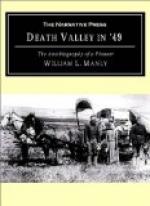At the top of these hills we had another beautiful view as far south and west as the eye could reach. Small objects, probably horses and cattle, were scattered about the plain, grazing in the midst of plenty. Our own animals were given frequent opportunities to eat, and again and again we rejoiced over the beauty. Of course it was not such a surprise and wonder as it was when such a view first burst upon our sight, but it pleased and delighted us ever. On the east was a snow-capped peak, and here we were in the midst of green fields of grass and wild flowers, in the softest climate of an early spring. These strong contrasts beat anything we had ever seen. Perhaps the contrast between the great snow mountain and the hot Death Valley was greater in point of temperature, but there the heat brought only barrenness, and of the two the snow seemed the more cheerful. Here the vegetation of all sorts was in full balance with the balmy air, and in comparison the snow seemed a strange neighbor. It was quite a contrast to our cold, windy March in Wisconsin, and we wonder if it is always summer here. We were satisfied that even if we could get no further we could live in such a land as this. The broad prairie doubtless belonged to the United States, and we could have our share and own a little piece of it on very easy terms, and raise our own cattle and corn. If the people were all as kind as those we had met we were sure at least of neighborly treatment. I have endeavored to write this just as it seemed to us then and not clothe the impressions with the cover of later experience. The impressions we then daily received and the sights we saw were stranger than the wildest fiction, and if it so strikes you, my friendly reader, do not wonder.
As we came over the hills we could see a village near the southern base and it seemed quite near us. It was a new and strange sight to us as we approached. The houses were only one story high and seemed built of mud of a gray color, the roofs flat, and the streets almost deserted. Occasionally a man could be seen, sometimes a dog, and now and then an Indian, sitting with his back to the house. The whole view indicated a thinly populated place, and the entire absence of wagons or animals was a rather strange circumstance to us. It occurred to us at first that if all the emigrants were gone our reception might be a cool one in this city of mud. One thing was in its favor and that was its buildings were about fire proof for they had earthen floors and flat roofs.
We rested half an hour or so just outside, and then ventured down the hill into the street. We met an American almost the first man, and when we asked about a suitable camping place, he pointed out the way and we marched on. Our strange appearance attracted the attention of the children and they kept coming out of the houses to see the curious little train with Old Crump carrying the children and our poor selves following along, dirty and ragged. Mrs. Bennett’s dress hardly reached below her knees, and although her skirts were fringed about the bottom it was of a kind that had not been adopted as yet in general circle of either Spanish-American or good United States society. The shortness of the dress made the curious raw-hide moccasins only the more prominent, and the whole make-up of the party was a curious sight.




